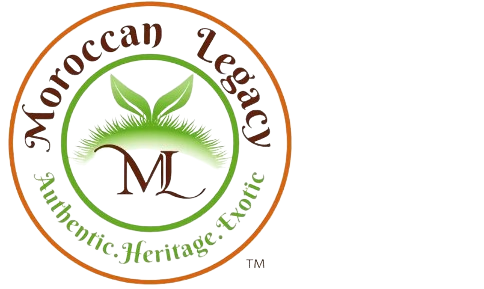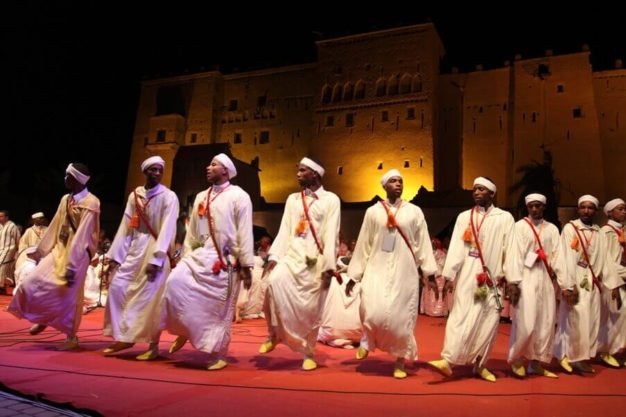Amazigh Dance: The Roots and the Origine
Ahwash dance is a traditional form of Berber music that is known for its liveliness and appeal. It is usually performed during Mahwah celebrations and is closely associated with church events and other significant cultural occasions. An “Ahwash” refers to a group of dancers that perform together, moving to alternating rhythms that range from slow and melodic to fast and upbeat. This dance style is a vital part of Berber traditions and is often accompanied by various musical instruments, including drums, flutes, and stringed instruments. The music and dance of Ahwash are an essential part of Berber culture, and people worldwide admire their unique beauty and energy.
 Credit to commons.Wikimedia
Credit to commons.Wikimedia
It is most common in the southern regions of Morocco. Thus, it belongs to the Berber “Amazigh” culture. Maintaining originality and preserving Ahwash’s historical and cultural identity is vital. This is because it presented an excellent legacy for generations to come.
It is prevalent in the High Atlas and Ouarzazate region and extends to other southern areas of Morocco. Ahwash dance creates a stunning presentation of Berber customs.
Ahwash dance varies across regions and tribes, with unique touches added to clothing and jewelry. However, its authenticity remains unchanged.
These events include:
- Wedding
- Small community gatherings
- Feast
- Festivals
Amazigh Dance: Some Other Facts about
- It is a group dance performed by the Amazigh locals, the indigenous peoples of Morocco.
- The Ahwash dance is coordinated by what is called TAWAL, orchestrated by a soloist. They are always in the Tamazight language, a “Tachalhit” dialect.
- The single round of an Ahwash session sometimes lasts 20 minutes. The performers of Ahwach consist of 25 to 30 performers from both men and women.
- Ahwash dance consists of drumming, clapping, and stomping movements that are well-coordinated while maintaining the lyrics.
- It is sometimes performed only by women, and sometimes it is performed exclusively only by men. Yet, it is always done in groups, even if it varies from region to region.
- In an Ahwash session, females wear lavish colors, mainly designed as Ahwash dance outfits. These outfits are mostly locally made.
Amazigh Dance: Traditional Rules That Every Dancer Follows.
- It opens with two alternating choirs, men and women, with the drums members’ support. Women stand around men who themselves are sitting around the fire they created.
- After remaining motionless, Ahwash dancers moved slowly while maintaining dance rules. This is with a slight swinging playing on the rhythms of drums while chanting.
- Male dancers and performers are standing or crouching at the center of the dancing square. They play “talloont” and “Bandeer.” The Bandeer is a wooden-framed framed drum about 12 to 18 inches.
- The Bandeer and Talluunt skin continuously stretches over the fire during the Ahwash session. The drums must always cross the neck by alternating choirs to maintain rhythm, consistency, and coordination.
- The rules of Ahwash can appear to be complicated to the audience. Yet, Ahwash members know exactly how to execute and perform it seamlessly without any effort because of their regular and routine practice.
During an Ahwash session, a traditional dance performance in North Africa, the rhythmic pattern gradually transitions from a symmetrical to an asymmetrical structure over approximately twenty minutes. The dancers performing the Ahwash rhythm do so with remarkable ease and finesse, even though the change in the rhythm category is not immediately apparent to the audience.
This shift is particularly impressive because the two linked rhythms are unique and distinct from one another, yet they are seamlessly connected with the continuum of the Ahwash. The intricate nature of this rhythmic progression underscores the skill and artistry of the performers, making for a truly captivating experience.
This traditional dance attracts thousands of attendees during the big summer celebrations. It is also practiced throughout the year, especially at weddings and celebrations.
National Ahwash Festival “The Arts of Ahwach and the Oasis cultures.”
The Ministry of Culture and Communication, a government body responsible for shaping cultural policies and promoting the arts in Morocco, takes pride in organizing the highly anticipated National Arts Festival. This annual event showcases the best of Moroccan arts and culture and is celebrated under a different theme each year. For the upcoming festival, the theme is “The Arts of Ahwach and the Oasis Cultures,” which promises to be a unique and exciting experience.
The festival is held in Ouarzazate’s historic and iconic Kasbah of Taourirt. This impressive fortress is a well-used space for the festival and symbolizes Moroccan culture and heritage. The Kasbah provides a perfect backdrop for the festival’s vibrant colors, sounds, and performances.
One of the festival’s main attractions is the Ahwash, a traditional dance and musical performance preserved for many years. This authentic art form is unique to the Atlas Mountains region of Morocco and has been passed down from generation to generation. The Ahwash groups come from different parts of the country and gather annually to showcase their talents.
The festival attracts thousands of visitors from within and outside Morocco who experience the country’s rich cultural heritage. They can expect to be entertained by various performances, including music, dance, poetry, and theater. The festival provides a platform for artists and performers to showcase their talent and an excellent opportunity for visitors to learn about Morocco’s culture and traditions.
Many traditional Amazigh costumes and local products are shared with their visitors. More than 600 artists participate in Ahwach during the National Arts Festival. The participating performers and artists represent some of the best Ahwach groups in Morocco. They are mainly from the southern regions of the country.

